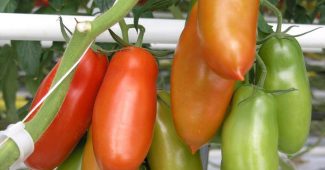You can find a pantheon of unique and unusual vegetables online. Growing some of them yourself with appropriate conditions is easier than you think. Since many rare cultivars are difficult to find, many gardeners grow them as an organic and money-saving option. Check out the following list to create a small garden featuring unusual veggies.
10Armenian Cucumber
Armenian cucumbers are not true cucumbers, but they often appear in culinary dishes due to their similar taste and structure to common cucumbers. These plants are perfect for hot climates, as they can withstand higher temperatures than most cucumber varieties. Armenian cucumbers are an excellent choice for gardeners in warmer regions who have struggled to grow traditional cucumbers.
Enriching the soil with compost is essential before planting. Even though they are more drought-tolerant than other cucumbers, consistent moisture is still necessary for optimal growth. Additionally, pruning suckers help control the vine’s spread and improve air circulation and sunlight exposure. For best results, plant Armenian cucumbers in July when the temperature is warm.
9Purple Dragon Carrot
Looking to add some color to your diet? Look no further than Purple Dragon Carrots, a unique and flavorful variety you can grow at home. These carrots offer a slight spiciness in addition to their sweet flavor and contain just as many lycopene and antioxidants as tomatoes. To plant them, simply obtain seeds from any heirloom seed supplier and prepare sandy or loamy soil that is weakly acidic.
For optimal growth, remember to sow seeds indoors 3-4 weeks before the last frost or outside in the full sun once the soil temperature reaches 60 degrees Fahrenheit. With their hardy and open-pollinated nature, these carrots can grow quickly and harvest at smaller sizes.
Top 10 Best Tomatoes to Grow in your Vegetable Garden
8Cucamelons
Cucamelons are a unique and fascinating vegetable within the cucumber family. Native to Mexico and Central America, cucamelons are sometimes called ‘Mexican sour gherkins’ or ‘mouse melons’. These small, grape-sized veggies have a tart and citrusy flavor, making them extremely refreshing. Additionally, they are rich in vitamins and minerals, making them the perfect addition to a healthy diet.
Growing cucamelons is relatively easy, as they require low maintenance. They prefer warm climates and typically grow from May, after the risk of frost. Plant them in well-drained, fertile soil with moisture content in full sun to ensure optimal growth. Regular watering and fertilizing with high potash are also essential.
7White Eggplant
White eggplants are a versatile and attractive variety known for their ivory, cream, or white skin. Although thicker-skinned than their purple counterparts, they offer a milder, less acidic taste with more seeds. For best results, peel the skin before cooking. These warm-season crops require ample sunlight, water, and nutrients, and staking is essential to support the weight of the fruit.
Whether planted in containers or garden soil, mid-spring is the ideal time to begin growing white eggplants when temperatures consistently exceed 50 degrees Fahrenheit. In mild winters, sow seeds directly in the garden or plant them indoors at least one month ahead of time to ensure optimal growth.
6Romanesco Broccoli
Romanesco Broccoli is a crazy-looking veggie belonging to the cauliflower and cabbage family member, with lime green heads packed with smaller florets that give it a unique flavor. Growing Romanesco broccoli is relatively easy since it requires only low maintenance. It prefers well-drained soil with plenty of sun.
Whether fresh or cooked, Romanesco broccoli is a delicious addition to any dish. It is especially great whether steamed, blanched, grilled, or in a salad. For best results, prepare your seedbed with organic material before sowing seeds. Plant in May in cooler zones, water regularly, and weed around the seedlings to prevent competition. Remember that Romanesco broccoli can bolt in high heat, so keeping it consistently moist is essential.
5Artichoke
Depending on the climate, you can plant Artichokes at different times of the year. In warm climates, they can grow as annuals, while in cooler climates, they can survive as perennials. Ensure well-drained but fertile soil and full sun exposure for optimal growth.
4Red Cabbage
Plant them in cooler temperatures and partial shade. Providing well-drained nutrient-rich soil with high organic matter is essential. Keep the soil moist through regular watering, especially when the plants are exposed to direct sunlight. Enjoy the tightly arranged, mature leaves that gradually form spherical or oval shapes during winter and autumn.
3Watermelon Radish
While finding watermelon radish seeds can be challenging, online seed catalogs offer a solution. These radishes are easy to grow but require patience, taking approximately 65 days to mature. Plant them in early to late spring in well-drained, deep, fertile soil rich in organic matter for best results. However, it’s worth noting that the root can become dry and bitter if exposed to hot soil temperatures.
2Painted Hill Corn
Their complex and starchy texture can offer extra nutrients and antioxidants. As the corn matures, the colors deepen from a softer hue to a deeply saturated shade. Being hardy, they can tolerate cold weather conditions and germinate at lower temperatures than other types. For best results, grow Painted Hill Corn in warm weather conditions with well-drained soil with high organic matter.
Related Articles
1Chioggia Beets
Chioggia Beets, also known as Bull’s Eye Beets, is a great choice, providing a unique touch to your garden. These beets have stunning rings of red and white and are surprisingly easy to grow. Plant them early in the spring in well-worked soil with high organic matter for optimal root growth.
Although they can grow in shades, planting them in full sun will yield the best results. For healthy root development, ensure a spacing of at least six inches and apply a dry, nitrogen fertilizer six weeks after the seeds germinate. By regularly watering, make sure to keep the soil moist and support healthy growth.




